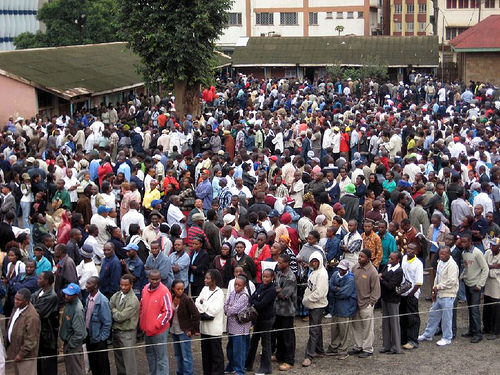Kenya Decides - The Kenya Election, Mobiles, and Interactive Media

The polling stations are slowly closing in Kenya in a so-far largely peaceful day. This is a critical election in one of the most technically-advanced countries in sub-Saharan Africa with many monitoring efforts underway as #kenyadecides (to use the Twitter hashtag of choice). While many predict that is going to be a run-off election, we wanted to give a 'rundown' of all the cool tech used that we are watching:
1. The IEBC, the Kenyan Election Commission, put up (with some help from Google) an interactive map and SMS service for people to find their voter registration stations, registration status, and polling station on election day. It also includes a candidate finder. While the map has some usability issues, it's become a very useful resource for citizens that only can be improved upon. It's a model for other independent election commissions that is commendable. IEBC's Facebook Page is also worth watching. Incidentally, by all accounts, the IEBC so far has done a great job providing security and ballots; it's also been very responsive to incident reports from both systematic election monitoring organizations and citizen reporting efforts. No small feat given the enormous voter turnout.
Most interestingly, IEBC promises to report election results in close-to real time using its API. UPDATE: The API from the IEBC with real-time election results data as the vote is counted is working fabulously and media houses in Kenya are pulling the data and transmitting it live on television. Unprecedented for Kenya.
2. Google, as is has in many other countries, has put up an Election Portal that aggregates news, citizen reports (edited by Storyful) and lots of Hangouts. The Portal also includes extensive candidate information. We would have liked some information there from and about the civil society organizations monitoring the election here. But the Google doodle the morning of the election on the Kenya Google home page was a nice touch.
3. ELOG (NDI's partner), the domestic election monitoring organization, has trained, during many months of hard work, 7240 citizen observers who are stationed at a randomly selected number of polling stations for the entire day, reporting back via SMS on the conduct and the results of the election. Because the number of polling stations is a representative sample and the reports are structured replies to a questionnaire, the incoming results that get parsed by a database are highly accurate. Observers report throughout the day and there is constant two-way communication between a central data center and the observes in the field to confirm and verify reports.
For instance, ELOG's observers reported statistically significant data on the opening of election day which showed that at only 59.7% of polling stations opened on time, but that there was security present at 99.6% of polling stations. ELOG's website, Facebook page and Twitter are good resources to follow as well for this kind of election data.
ELOG will be reporting until well into the night as polling stations are slowly closing and is promising more maps and infographics.
4. Uchaguzi, a project of the citizen-reporting organization Ushahidi, launched an ambitious and very interesting hate-speech monitoring effort in the pre-election period and issued regular reports in the advent of the election. This was a fascinating project that we watched closely to see how to integrate better social media monitoring into our work. Ushahidi is also running a more traditional citizen-reporting effort with anyone being able to report information about the election. Interestingly, unlike in many of the instances of the platform where there is no feedback loop or action after a report is submitted but a citizen, Uchaguzi installed (as it did in a few other elections where the organization was directly involved) a situation room to verify critical incidents and escalate them to election authorities (though at the time of this writing the situaltion room link is down). As usual, the team at Ushahidi is doing a great job innovating in the citizen reporting space. We continue to be impressed.
5. There are lots and lots of candidate finder sites for the Kenya election. The one that seemed to have gotten the most attention is Wenyenchi that also has a mobile site (quite beta, though) and an Android app. We have not fully tested it but it provides a good overview of candidates and an electoral boundary-finder (though when we played with it it was a bit buggy).
Al Jazeera English has a great interactive dashboard with candidate information, boundaries, it's interactive SMS 'Speak' platform that allows citizen voices to be heard, and interactive poll data. We are big fans of Al Jazeera English's interactive and social media innovations.
6. There are many other efforts that aggregate social media on #kenyadecides. We just looked at Crowdvoice's election-related aggregation which, while not quite complete (we wonder how the pictures andvideos that show up are chosen?) nonetheless an interesting platform.
We are sure we missed lots of innovative efforts here, though! Leave us a comment or tweet us at @nditech and we'll add more projects as we hear about them. Good luck with the vote, Kenya!
Photo credit to Ian Schuler
